- Clone Graph
中等
https://leetcode-cn.com/problems/clone-graph/
Given a reference of a node in a connected undirected graph.
Return a deep copy (clone) of the graph.
Each node in the graph contains a value (int) and a list (List[Node]) of its neighbors.
class Node {
public int val;
public List<Node> neighbors;
}
For simplicity, each node's value is the same as the node's index (1-indexed). For example, the first node with val == 1, the second node with val == 2, and so on. The graph is represented in the test case using an adjacency list.
An adjacency list is a collection of unordered lists used to represent a finite graph. Each list describes the set of neighbors of a node in the graph.
The given node will always be the first node with val = 1. You must return the copy of the given node as a reference to the cloned graph.
Input: adjList = [[2,4],[1,3],[2,4],[1,3]]
Output: [[2,4],[1,3],[2,4],[1,3]]
Explanation: There are 4 nodes in the graph.
1st node (val = 1)'s neighbors are 2nd node (val = 2) and 4th node (val = 4).
2nd node (val = 2)'s neighbors are 1st node (val = 1) and 3rd node (val = 3).
3rd node (val = 3)'s neighbors are 2nd node (val = 2) and 4th node (val = 4).
4th node (val = 4)'s neighbors are 1st node (val = 1) and 3rd node (val = 3).
Example 2:
Input: adjList = [[]]
Output: [[]]
Explanation: Note that the input contains one empty list. The graph consists of only one node with val = 1 and it does not have any neighbors.
Example 3:
Input: adjList = []
Output: []
Explanation: This an empty graph, it does not have any nodes.
Constraints:
The number of nodes in the graph is in the range [0, 100].
1 <= Node.val <= 100
Node.val is unique for each node.
There are no repeated edges and no self-loops in the graph.
The Graph is connected and all nodes can be visited starting from the given node.
相关企业
- Facebook|36
- 亚马逊 Amazon|8
- 谷歌 Google|6
- 彭博 Bloomberg|6
- 微软 Microsoft|3
相关标签
- Depth-First Search
- Breadth-First Search
- Graph
- Hash Table
相似题目
- Copy List with Random Pointer 中等
"""
# Definition for a Node.
class Node:
def __init__(self, val = 0, neighbors = None):
self.val = val
self.neighbors = neighbors if neighbors is not None else []
"""
class Solution:
def cloneGraph(self, node: 'Node') -> 'Node':
if not node:
return None
# get all nodes then copy all nodes
allOldNodesSet = self.getAllNodes(node)
# create new nodes and map old node to new node
old2NewMap = {}
for oldnode in allOldNodesSet:
old2NewMap[oldnode] = Node(oldnode.val)
# copy neighbors
for oldnode in allOldNodesSet:
newnode = old2NewMap[oldnode]
for oldneighbor in oldnode.neighbors:
newneighbor = old2NewMap[oldneighbor]
newnode.neighbors.append(newneighbor)
# return new root node
return old2NewMap[node]
def getAllNodes(self, root):
queue = collections.deque([root])
allOldNodesSet = set([root])
while queue:
currnode = queue.popleft()
for neighbor in currnode.neighbors:
if neighbor in allOldNodesSet:
continue
allOldNodesSet.add(neighbor)
queue.append(neighbor)
return allOldNodesSet